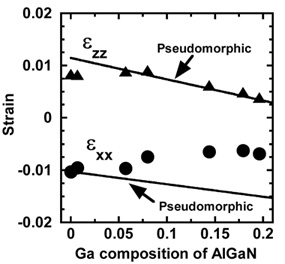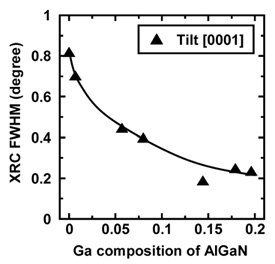Materials Science Laboratory
Nitride semiconductor films with non-polar faces, such as (1100) and (1120) faces, are attracting much attention, because emission efficiency of
quantum wells using the non-polar faces is higher than those using polar
faces, such as (0001) face, by the elimination of piezoelectric polarization
fields [1]. On the other hand, SiC has been widely used as the substrate
for heteroepitaxy of nitride semiconductors, because of its high electrical
and thermal conductivities and the smaller lattice mismatches (〜1% for
AlN). However, there is anisotropy in the lattice mismatches between nonpolar
nitride semiconductors and SiC substrates and the lattice matching of the
heteroepitaxy is complicated. For example, the a- and c-axes of AlN are 1.05% longer and 1.13% shorter than those of SiC, respectively.
In this study, we have grown Al1-xGaxN (1120) thin films (x<0.2) on SiC (1120) substrates and evaluated the lattice constants, in-plane strains and
crystallinity of the films.
The pseudomorphic growth (lattice-matched with substrate) is essential
for heteroepitaxy for reducing the densities of dislocations and stacking
faults. Figure 1 shows dependence of in-plane strains in Al1-xGaxN (1120) thin films on the Ga composition. The in-plane strains along the [1100] and [0001] directions, εxx and εzz, are on the pseudomorphic lines at the Ga compositions lower than 0.06,
which means that the in-plane lattice constants of the films are almost
the same as those of SiC. This pseudomorphic growth is successfully achieved
by balance between compressive stress along [1100] and tensile one along [0001] [2]. Dependence of full width at half maximum (FWHM) of (1120) X-ray rocking curves (XRC) is plotted as a function of the Ga composition
in Fig. 2. The tilt angle toward [0001], tilt [0001], which is related
to the density of stacking faults parallel to the (0001) plane, decreases
by increasing the Ga composition. This is because the in-plane strain along
the [0001] direction, εzz, decreases by increasing the Ga composition (see Fig. 1).
The pseudomorphic growth of Al1-xGaxN (1120) thin films (x<0.06) are achieved in this study. In addition, our
findings can provide a basic guideline for the design of nonpolar light-emitting
devices, because both the band structures and the polarization of the emitted
lights can be modified by anisotropic strains.
[1] P. Waltereit et al., Nature 406 (2000) 865.
[2] T. Akasaka, Y. Kobayashi, and M. Kasu, Appl. Phys. Lett. 93 (2008) 161908.
 |
 |
|||||
|
|